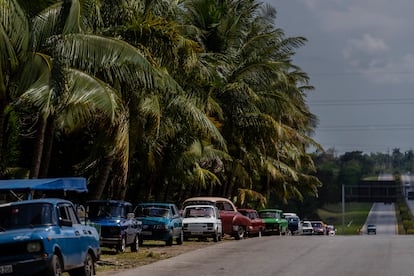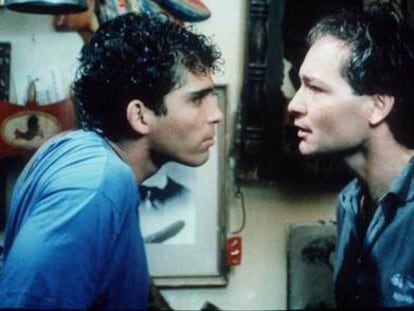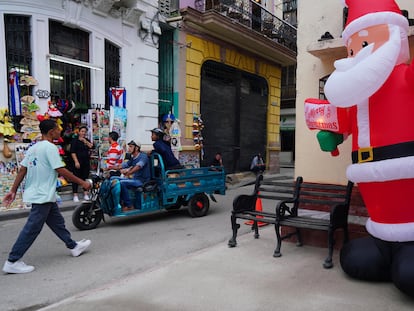Cuba increases price of gasoline by over 500% in the midst of the crisis
A liter of regular gas will rise from $0.20 to $1.10, and this is just one of the measures planned for this year, along with hikes to electricity, water and public transit

The Cuban government announced this week that it will raise the price of gasoline by more than 500% as of February 1, a decision that is part of a package of economic measures designed to alleviate the crisis in 2024, but which will make life on the island more difficult. Since late last year, authorities had been talking about a possible increase in the price of fuel, which has now just materialized. During an address before the Economic Affairs Commission of the National Assembly of People’s Power (ANPP) in December, President Miguel Díaz-Canel maintained that Cuba has “perhaps the cheapest fuel in the area, one of the cheapest in the world,” and that, therefore, “almost everyone here agrees that it should be raised.”
Later, Prime Minister Manuel Marrero Cruz announced a package of measures that, among other things, contemplated an increase in the price of fuel. “In what country in the world can you buy nine liters of gasoline with one dollar?” said Marrero. Finally, on Monday of this week, Finance Minister Vladimir Regueiro confirmed that a liter of regular gasoline, which at the moment has a value of 25 Cuban pesos (0.20 U.S. cents), will cost 132 Cuban pesos ($1.10). Likewise, special gasoline will rise from 30 pesos (0.25 cents) to 156 Cuban pesos ($1.30), a significant increase that the country’s drivers will have to contend with this year. Cuban leaders failed to mention, however, that fuel prices were low compared to prices anywhere in the world, but not in a country where the Cuban peso is increasingly weak against the dollar and where the monthly minimum wage is 2,100 Cuban pesos ($17.50).
With this measure, the authorities are bringing fuel prices in line with the current official exchange rate of approximately 120 pesos to the dollar. In the informal market, the dollar oscillates between 260 and 270 Cuban pesos. According to the Minister of Energy and Mines, Vicente de la O Levy, this increase “is intended to buy fuel, to be able to restock [...] to continue buying” and “to achieve a stable supply.”
From now on, tourists who visit the country must buy fuel in dollars through electronic payment methods at the 28 new service centers that the government has created to back up the measure, and which add to the network of 613 already in place. “The tourism sector and foreign visitors who come to the country exchange the foreign currency they bring at 120x1, however, the price of gasoline is currently at 24x1. It is there that we can see the subsidy for tourism, for people who elsewhere in the world pay gasoline at $1.30, while here they are paying it at 30 Cuban pesos,” said Levy.
Cubans are not only beginning 2024 with a rise in the price of gasoline, but also with a hike in the electricity bill, which will increase by 25% in some homes starting March 1. The prices of water, public transit and gas canisters will also go up. The authorities have recognized that these increases will be a blow to Cuban families. “This is going to directly impact the population,” Marrero said.
During the last two years, Cuba has experienced one of the most notable crises in its history, with inflation hovering around 30%, a bleak scenario that for many has already surpassed the so-called Special Period of the early 1990s. During 2023, Cubans suffered countless hours of power blackouts and long lines to buy fuel, a situation that the authorities blamed on the United States economic embargo on Cuba and on the failure to comply with agreements by countries that supply gasoline to the island.
Sign up for our weekly newsletter to get more English-language news coverage from EL PAÍS USA Edition
Tu suscripción se está usando en otro dispositivo
¿Quieres añadir otro usuario a tu suscripción?
Si continúas leyendo en este dispositivo, no se podrá leer en el otro.
FlechaTu suscripción se está usando en otro dispositivo y solo puedes acceder a EL PAÍS desde un dispositivo a la vez.
Si quieres compartir tu cuenta, cambia tu suscripción a la modalidad Premium, así podrás añadir otro usuario. Cada uno accederá con su propia cuenta de email, lo que os permitirá personalizar vuestra experiencia en EL PAÍS.
¿Tienes una suscripción de empresa? Accede aquí para contratar más cuentas.
En el caso de no saber quién está usando tu cuenta, te recomendamos cambiar tu contraseña aquí.
Si decides continuar compartiendo tu cuenta, este mensaje se mostrará en tu dispositivo y en el de la otra persona que está usando tu cuenta de forma indefinida, afectando a tu experiencia de lectura. Puedes consultar aquí los términos y condiciones de la suscripción digital.
More information
Archived In
Últimas noticias
Chris Martin, Taylor Swift, Elijah Wood and other famous wedding ‘crashers’
‘How does it feel to be a failure?’: Elizabeth Berkley’s journey from ‘Showgirls’ ridicule to vindication
The story of the Málaga virus: The code that haunted Google’s cybersecurity center director for 30 years
The impact of Ecuador’s mega-prison: A polluted river, cleared forests and military checkpoints
Most viewed
- Christian Louboutin: ‘Young people don’t want to be like their parents. And if their parents wear sneakers, they’re going to look for something else’
- The low-cost creative revolution: How technology is making art accessible to everyone
- Liset Menéndez de la Prida, neuroscientist: ‘It’s not normal to constantly seek pleasure; it’s important to be bored, to be calm’
- All the effects of gentrification in one corner of Mexico’s Colonia Roma
- December Social Security and SSI payments: Dates, double checks and the 2026 COLA increase











































